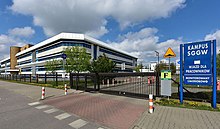Warsaw University of Life Sciences
Szkoła Główna Gospodarstwa Wiejskiego (SGGW) | |
 | |
| Type | Public |
|---|---|
| Established | September 23, 1816 |
| Rector | Prof. dr. hab. Michał Zasada |
Administrative staff | 2,685 (2017)[1] |
| Students | 16.443 (2018)[2] |
| Address | Nowoursynowska 166, 02-787 , , Poland |
| Campus | Urban |
| Affiliations | Leonardo Da Vinci, SOCRATES, BUDDY, CEEPUS, ARENA, PHARE-SCI-TECH, PHARE-ACE, SENECA, COST, JEAN MONET, FAIR, TEMPUS |
| Website | www.sggw.pl |
 | |
| University rankings | |
|---|---|
| Regional – Overall | |
| QS Emerging Europe and Central Asia[3] | 91 (2022) |
The Warsaw University of Life Sciences (Template:Lang-pl, SGGW) is the largest agricultural university in Poland, established in 1816 in Warsaw. It employs over 2,600 staff including over 1,200 academic educators. The University is since 2005 a member of the Euroleague for Life Sciences (ELLS) which was established in 2001. The SGGW offers some 37 different fields of study, 13 faculties in Agricultural Sciences, Economic Sciences, Humanities, Technical as well as Life Sciences. Its Agriculture and Forestry and Veterinary Medicine have been ranked as top 41 and 51-70 in the world on QS top university ranking 2023.
History
On 23 September 1816 the School of Agronomy was founded at Marymont and was accommodated in the palace of Marie Casimire Louise de La Grange d'Arquien. Branches were established at Bielany, Ruda, Wawrzyszew and Buraków. An Institute of Veterinary Medicine was established at Rządowa, followed by the Institute of Rural Economy and Forestry in 1840. As Poland was ruled by the Tsar of Russia there were attempts at Russification which nearly resulted in the closure of the school, but it was transferred first to Puławy and later to Russia. After the independence of Poland in 1918 the Institute was returned to Warsaw and became the Major School of Rural Economy in 1919. Horticultural studies were added to those of agriculture and forestry in 1921. Activity was disrupted by the Second World War and resumed in 1945. The veterinary faculty was transferred from the University of Warsaw in 1952, and later the departments of agricultural drainage, wood technology, animal husbandry, and of landscape, now known as the Landscape Architecture Section, were established. Land and farms at Wolica and Natolin were acquired in 1956 and used for development. In 1973 the faculties of agricultural technology and human nutrition were established. The Rector of the university has an office in the historic palace of Julian Ursyn Niemcewicz, now known as "the rector's palace."
Campus



The campus is located is the southernmost district of Warsaw, Ursynów. The campus has a historic part, with an 18th century palace, and a contemporary part where most of the faculty buildings and dormitories are situated. On 70-hectare main campus are located 12 dormitories, a modern library, a sports centre (with tennis courts, a sports hall and a swimming pool) a language centre, a veterinary clinic.[4]
Faculties[5]
- Agriculture and Ecology
- Animal Breeding, Bioengineering and Conservation
- Applied Informatics and Mathematics
- Biology and Biotechnology
- Civil and Environmental Engineering
- Economics
- Food Technology
- Forestry
- Horticulture
- Human Nutrition
- Sociology and Education
- Production Engineering
- Wood Technology
- Veterinary Medicine
Notable staff

- Józef Mikułowski-Pomorski (1868–1935), politician, agricultural chemist; Minister of Religious and Public Enlightenment 1922–1923, 1926

- Władysław Grabski (1874–1938), politician, economist and historian; Prime Minister of Poland 1923–1925; founder of the Bank of Poland and the Polish currency[6]
- Stefan Ignar (1908–1992), politician, economist, Deputy Prime Minister of the Republic of Poland 1956–1969
Rectors
- Józef Mikułowski-Pomorski (1918–1920)
- Tadeusz Miłobędzki (1920–1921)
- Stefan Biedrzycki (1921–1922)
- Wacław Dąbrowski (1922–1923)
- Jan Sosnowski (1923–1925)
- Zdzisław Ludkiewicz (1925–1926)
- Władysław Grabski (1926–1928)
- Józef Mikułowski-Pomorski (1928–1929)
- Stefan Biedrzycki (1929–1932)
- Jan Sosnowski (1932–1933)
- Marian Górski (1933–1936)
- Jan Miklaszewski (1936–1944)
- Franciszek Staff (1944–1947)
- Marian Górski (1947–1949)
- Antoni Kleszczycki (1949–1955)
- Kazimierz Krysiak (1955–1962)
- Antoni Kleszczycki (1962–1969)
- Zbigniew Muszyński (1969–1975)
- Henryk Jasiorowski (1975–1981)
- Maria Joanna Radomska (1981–1987)
- Wiesław Barej (1987–1990)
- Jan Górecki (1990–1996)
- Włodzimierz Kluciński (1996–2002)
- Tomasz Borecki (2002–2008)
- Alojzy Szymański (2008–2016)
- Wiesław Bielawski (2016–2020)
- Michał Zasada (since 2020)
Notes
- ^ Grażyna Majewska (29 May 2017). "Plan rzeczowo-finansowy na 2017 rok" (PDF). BIP SGGW. Retrieved 16 November 2017.
- ^ Szkoły wyższe i ich finanse w 2018 roku, p. 68
- ^ "QS World University Rankings-Emerging Europe & Central Asia". Retrieved 15 January 2023.
- ^ "General information about university". sggw.pl. Retrieved 12 February 2018.
- ^ "FACULTIS WULS-SGGW". Archived from the original on 2019-11-07.
- ^ Janusz Skodlarski (2016). Władysław Grabski jako ekonomista (1874–1938). Wydawnictwo Uniwersytetu Łódzkiego.
